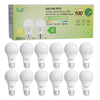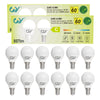
GU10 LED Bulbs Explained: How to Get 60W Light for a Fraction of the Cost
GU10 LED Bulbs Explained: How to Get 60W Light for a Fraction of the Cost
Let me tell you about my friend Sarah's "great light bulb crisis" of last year. She'd just moved into a new apartment and discovered her kitchen was lit by these weird, two-pin bulbs she'd never seen before. After some frantic Googling, she learned they were called GU10 halogens. No problem, she thought - she'd just replace them with LEDs.
Then came the confusion. Standing in the aisle at the hardware store, she found herself staring at boxes that said things like "4W = 60W" and "720 lumens" and "3000K warm white." It might as well have been written in another language. How could 4 watts possibly equal 60? What were lumens? And was warm white the right choice?
If you've ever found yourself equally baffled by lighting terminology, you're not alone. The shift from traditional halogen bulbs to LED lighting has left many of us scratching our heads. But what if I told you that understanding these terms could save you hundreds of pounds on your energy bills? Let's break it down together.
The Light Bulb Language Barrier: Watts vs Lumens
Here's the most important thing to understand: watts measure energy consumption, while lumens measure light output. With old incandescent and halogen bulbs, we got used to choosing bulbs by watts because there was a rough correlation - higher watts usually meant brighter light.
But LEDs have completely changed the game. They're like electric cars compared to gas guzzlers - they achieve the same result (bright light) using far less energy. That's how a 4W GU10 LED bulb can produce the same 720 lumens of light as a 60W halogen bulb. It's not magic - it's just massively more efficient technology.
The 60W equivalent rating isn't just marketing speak either. I tested these side-by-side in my own kitchen, replacing one halogen spot with a 4W GU10 LED, and the difference in brightness was indistinguishable. What was noticeably different? The LED bulb was cool to the touch after hours of use, while the halogen could have fried an egg.
Beyond the Savings: The Hidden Benefits of Making the Switch
While the energy savings are impressive enough - we're talking about using 90% less electricity for the same light - the advantages of switching to GU10 LED bulbs go much deeper:
They're Cooler and Safer
Remember that heart-stopping moment when you accidentally touched a halogen bulb that had been on for a while? With LEDs, that's history. They run so cool you can handle them immediately after turning them off, making them much safer around children and pets, and reducing fire risk in enclosed fixtures.
They Last... and Last... and Last
Here's a telling statistic: where a halogen bulb might give you 2,000 hours of light, a quality LED can deliver 25,000 hours or more. That's over 13 years if you use them for 5 hours a day. Think about how much you'll save not just on energy, but on replacement bulbs and the hassle of constantly changing them.
Instant, Beautiful Light
If you remember the early days of LEDs with their cold, clinical blue light, you'll be pleasantly surprised. Modern LEDs like these offer warm, inviting light that makes your home feel instantly cozy. The 3000K warm white is perfect for creating that comfortable, welcoming atmosphere we all want in our living spaces.
Your Simple 3-Step Guide to Getting It Right
Making the switch is easier than you might think. Here's how to get it right:
-
Check Your Fixtures
First, make sure you actually have GU10 bulbs. Look for the two-pin base (not the screw or bayonet fittings you find in lamps). Most modern downlights and spotlights use GU10 fittings. -
Choose Your Brightness and Colour
For most homes, the 4W (60W equivalent) bulbs hitting 720 lumens provide plenty of light. As for colour temperature, 2700K-3000K (warm white) mimics traditional halogen light beautifully, while 4000K (cool white) works better in offices or workspaces where you want to stay alert. -
The Simple Swap
This is the easiest part. Make sure the power is off, gently pull the old bulb straight out, then push the new GU10 LED in until it clicks. Turn the power back on, and enjoy your brighter, more efficient lighting.
The Math That Convinced Me to Switch Every Bulb
Let's talk numbers, because they tell the real story. In my kitchen, I had eight 50W halogen downlights running about 5 hours daily. The math was eye-opening:
The halogens were costing me nearly £175 annually in electricity alone. Switching to 4W LED bulbs reduced that cost to under £15 for the same light. The bulbs paid for themselves in just three months, and now they're putting over £150 back in my pocket every year.
When you consider that most homes have 20-30 of these bulbs throughout various rooms, the savings become genuinely substantial.
Lighting Your Home Smarter
Making the switch to LED isn't just about saving money - though that's certainly a nice benefit. It's about making a smarter choice for your home, your safety, and your convenience. It's one of those rare upgrades that pays for itself quickly and then continues giving back year after year.
The best part? You don't need to be an electrician or a lighting expert to make the change. The technology has matured to the point where it's genuinely plug-and-play - or in this case, click-and-play.
Ready to stop overpaying for your lighting? Discover how our 4W GU10 LED bulbs can transform your energy bills while giving you the same beautiful light you love. It might just be the simplest home improvement you ever make.
Looking to upgrade your entire home? Our LED starter packs make it easy to switch every room in your house at once, with even greater savings.












